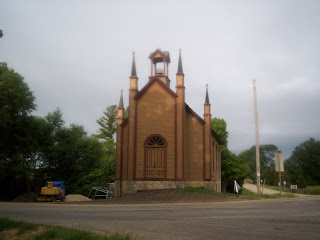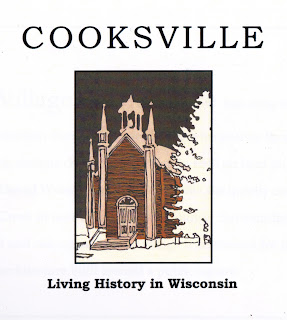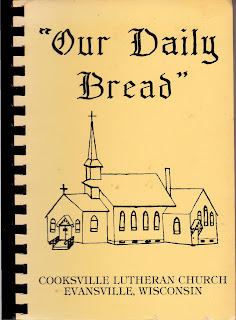In the 19th and 20th centuries, the little Village of Cooksville, founded in 1842 on an endless prairie with oak-opening in southern Wisconsin, received a good
amount of attention. Facts of life in that early Village are contained in the
first settlers’ letters, diaries and scrapbook, as well as in the first area newspapers
and publications and in the research and writings of Cooksville’s historians.
These bits and pieces—mostly
facts, some gossip— give glimpses of life
including its fancy new wooden sidewalks
and the frequent fresh oyster which were suppers supplied in salt-water-filled
wooden barrels from distant Milwaukee or Chicago. Here are a few glimpses:
Vote at first town
meeting, April 6, 1847: “ For Equal Sufferage (sic) – Twenty-Eight.
Against Equal Sufferage (sic)
– Thirty Four.”
“The first church at
Cooksville was organized in 1842, a Free Will Baptist church with 12 or 16
members, who held their meeting in Mr. Cook’s log house. Their pastor was Elder
Low who preached without a salary. He had a small farm where he made a living
like the other settlers. The first yearly meeting was held in a saw-mill that
Mr. Cook had erected and was largely attended.”
“Up to 1848, the principal
centers of business for the whole country between Janesville and Madison were
at the village of Union or Cooksville, on the Badfish creek…”
Town of Porter Meeting,
April 1, 1856: “A Resolution was presented to the Electors to prevent pigs from
running at large upon the Highways under a penalty of Five Dollars was postponed…until the next
annual meeting.” April 7, 1857: “Resolved that all Sheep and Swine in the Town
of Porter be restrained from going at large on the Highways under the penalty
of fifty cts for each head found running at large.”
“Post office established
in Cooksville in 1849, mail brought horseback from Union…” “Official letter, dated 24 Dec 1864,
designating Cooksville Post office 5th class, setting the salary of the
Postmaster at $37 annually…”
.jpg) |
| Cooksville General Store c.1930s |
Masonic Lodge. Jan. 20,
1859: “Trustees leased the second story
of the store now owned by Abigail Woodbury to be used for a Masonic Hall at $50
for the first year, $45 for the next three, lease to run for four years …” “Specifications
for hall drawn up in 1864; contract provided for completion by August 1, 1864…”
Dec.16, 1864: “:…master and wardens bought store….” Dec. 1879: “…a few days
papering and otherwise repairing the Masonic Hall…with new chandeliers, new
carpets…this is now a very attractive room.” Sept 1882: “The Masonic Lodge are improving
their building by a new front to the store.”
Dec. 17, 1873: “Stage to
Stoughton via Union, Cooksville, &c will leave here (Evansville) at 7:45 a.m.
instead of nine o’clock, as heretofore, and return about 8 o’clock same
evening, Tuesdays, Thursday and Saturdays.”
 |
| Arrow-heads found in Rock County |
1875. “Mr. Hoxie found, a
few days since, an unfinished arrow, a spear head, convex on one side, slightly
concave on the other, which measures five inches long and two and one-fourth
wide. This is one of the largest of this kind of Indian relics ever found in
that vicinity.”
 |
| Cooksville Congregational Church (1879) with horse/carriage shelter at rear |
Jan.1879: “Understand that
our friends at Cooksville are about to perfect an organization that foreshadows
the building of a church this season.” Feb. i879: “The people of Cooksville
have finally located their church on the corner as you pass by the Union road. The
location affords good ground for a basement, which they purpose to construct in
connection with their church properly.
Dec. 18, 1879: The great event for the last week was the dedication of
the new church, and it was a good omen to see Methodist, Baptist,
Congregationalist, Universalist and Unitarian all on one platform… The basement
of the church will now be finished as soon as possible, with assembly room for
Lodge meetings, sociables, lectures, &c., &c., and at one end a furnace
room, kitchen, closets and stairway...”
1875. “The terrible mud
has started a subscription paper to raise funds to build sidewalks and enough
has been pledged to lay them on streets where most needed… So, hurrah for the
sidewalks.” April 1875: “The sidewalks are laid down, or at least enough so
that one can get to the post office without getting lost in the mud…” 3 May 1878: “ This town is putting on some
style with side walks, and now a street lamp at the crossing in front of Mr.
Robertson’s store. “
Dec. 5, 1879: ”This ‘burg’
is putting on metropolitan airs with four street lamps. Mr. James Fairgrieves,
our tinner, has displayed both taste and skill, besides a generous gift of a
fine street lamp, and the same has been put in position at the corner of the
church by B.S. Hoxie.”
July 28, 1880: “Cooksville
Gossip: Sunday while Mrs. Aris of Janesville was walking down town she fell
through one of our trap sidewalks and received some slight injuries,”
1879. “A visit to the mill formerly owned by N.
Davenport but now by W. Leedle & Son, shows it is much improved.” April`1881:
“About a dozen boys had some rare sport one day last week. As the gates of the
upper mill were shut down to make some repairs, they discovered fish by the
hundreds and spears, pitch-forks and the hands scooped them out. So for once about
every family in town had fresh fish for breakfast.”
“Evansville Review Feb.
22, 1882. [T]he current tobacco boom… In 1881, 12,000 acres of tobacco in
Wisconsin; Dane County 4,8674 acres; Rock County 5,704 acres. Banner town in
state Christiana, Dane County, with 1,125 acres; second is Porter, Rock County,
with 1,118 acres. “
 |
| Tobacco barn, now demolished |
1883: (Christopher) Preston & (John)
Searles, broom and brush manufacturers of Cooksville, are turning out good work
and will sell at wholesale as cheap as any house this side of Chicago…making six dozen brooms
a day” “…1887: “ In the old Hoxie shop:…received a large shipment of broom corn
Tuesday, with a large demand for their make of brooms..” 1890: “Mr. Jack Robertson (blacksmith) now occupies the
shop…formerly used as a broom factory.”
 |
| Robertson Blacksmith Shop |
1883. Cooksville: “This is
indeed a land of artists. Most every other one you meet has brushes and a
palate or an easel under his arms.”
Enterprise Newspaper. From
Cooksville, Feb. 4th, 1885: “Our library prospects are so flattering
that I cannot resist the desire to inform your readers of its future outlook. A
few of us banded together last December and incorporated a ‘Public Library
Association of Cooksville’ and since January first we have accumulated upwards
of $40 and no skating rink about it either. We hold sociables every two weeks,
Last night we had a box sociable where the ladies brought nicely decorated
boxes and the gents bid them off at various prices. The boxes brought by Mss.
Belle Rice and Miss Mable Woodbury sold each for $1.25….Next week, the Editor
willing, I will give the list of books just received.”
%20dress%20maker%20(640x500).jpg) |
| Belle Rice in her parlor |
Enterprise Newspaper. Dec.
15, 1885: “Social Life. The Cooksville people seem to enjoy themselves about
the best of any community we know of…they have had some delightful gatherings
where all joined together as one family without any jealousies or hard
feelings, and no scandals or brawls have their starting place there. As a
progressive, literary, talented people we think they are above the average.”
Enterprise Newspaper, Dec.
22, 1885: “The ‘Jolly Club,’ of Cooksville, will give a rousing New Year’s
Party at the Masonic Hall in that place on New Year’s Eve.” Jan. 1886:“The
Jolly Club dance was an entire success, about thirty couples in attendance…Arrangements
are in progress for the laying of a new canvass (on the wood floor) so the ladies can wear their Cinderella
slippers.”
 |
| Electa Savage with Paul and Avis c.1880 |
Enterprise Newspaper.
Feb.6, 1889: “We understand that Mrs. J.E. Savage is having her ice house ready
for the summer campaign. We can almost taste her cool and refreshing icings as
we write.”
 |
| Cooksville's Public Square, created in 1846 |
July 20, 1889:
“Cooksville: The workmen have begun working on the race track around d the park
(Pubic Square) which will be ready to drive on in a few
days…. June races will take place on this track in the future…” Sept. 4, 1889: “The
race track is nearly ready for use. There will be a base ball ground laid out
and all league clubs including Evansville and Chicago will be invited to play
on this ground.” Oct. 12, 1889: “Our
Race Track is now in good condition for driving. Driving tickets can be
purchased at the Post Office or the Broom Factory.”
Wisconsin Tobacco
Reporter. 6 Nov.1891: “E.M. Stebbins has
been appointed postmaster at Cooksville in place of C.H. Woodbury, resigned.
Mr. S. (Stebbins) is the successor of
Woodbury in the store at that village.”
Tobacco Reporter. 9 Oct.1903:” The Cooksville post office has
been discontinued and all mail formerly addressed to that office should be
addressed to Evansville RFD.”
Wisconsin Tobacco Reporter,
22 June 1894: “Cooksville: Mr. Forest’s
family arrived from Chicago Tuesday and is living in what is known as the
Collins House. Mr. Forest has the frame up for his new blacksmith shop... That
makes five blacksmith shops in town: Graves, Berry, Courter, Hanson and
Forest.”
.jpg) |
| Graves Blacksmith Shop, restored |
Dec, 8, 1894. Cooksville: “Carpenters are at
work on the 24 ft addition to the store. The Masonic Hall will be enlarged and
the room over the new part will be used as a dining hall.”
 |
| Good Templars at work (but not Cooksvillians) |
1895. “Good Templar
members… at a meeting on January 12, 1895… 8 gallons of oysters were disposed
of and a barrel of crackers was cleared.”
.jpg) |
| Ralph Warner at his "House Next Door" in Cooksville c1920 |
1912. Cooksville..:“Mr. Ralph Warner is settled in
his new house (Duncan House) which he purchased principally because the
old-fashioned fireplace appealed to his love of old things….It is finished up
in an old style… He loves everything that is old and is pleased to show his
curios to interested friends. We will tell more of him later on.”
[From items in the Cooksville Archives and Collections. Larry Reed]
* * *




.jpg)













.jpg)


.jpg)
.jpg)




%20dress%20maker%20(640x500).jpg)


.jpg)

.jpg)
.jpg)

.jpg)


.JPG)

.jpg)


.jpg)
.jpg)

%20photo%20c1880s_NEW.jpg)

.jpg)
.jpg)

.jpg)
